by David Clarke | Nov 15, 2012 | African Birds, All, Birds, Kenya, Wildlife
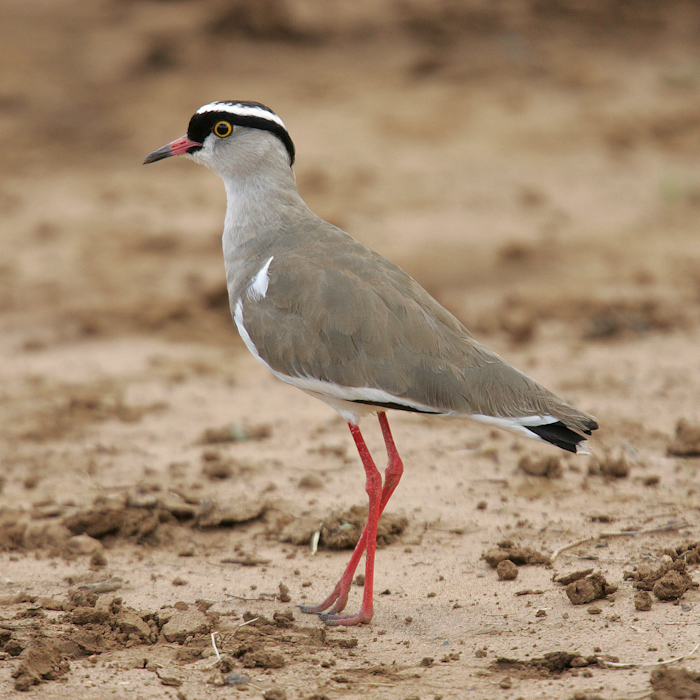
This Crowned Lapwing was seen at the Solio Game Reserve, a private 18000 acre reserve just north of Nyeri in central Kenya. Solio has been successful in breeding black rhino and over 120 black and white rhino live there. One appealing feature of the reserve is that you just pay your entrance fee and drive yourself around. It’s quiet and has none of the zebra stripe painted jeeps full of tourists vying for position to get the next shot. At Solio, you just take your time.
According to ‘Birds of East Africa’ by Stevenson and Fanshawe, ‘the crowned lapwing is a bird associated with dry country and grasslands, best identified by head, breast and wing markings. All resident species are known as plovers in Southern Africa. The Crowned Lapwing, (Vanellus coronatus) is 31cm, 12″, has a smart head pattern with a black cap and white crown ring standing out at long distance; the ring accentuates the flat head and steep forehead. It is alert and upright, with yellow eyes and bright red legs.’
Canon 1DMkII with Canon 300mmf2.8L IS lens and x2 extender; ISO400 f5.6 1/640
by David Clarke | Nov 12, 2012 | African Birds, All, Birds, Kenya
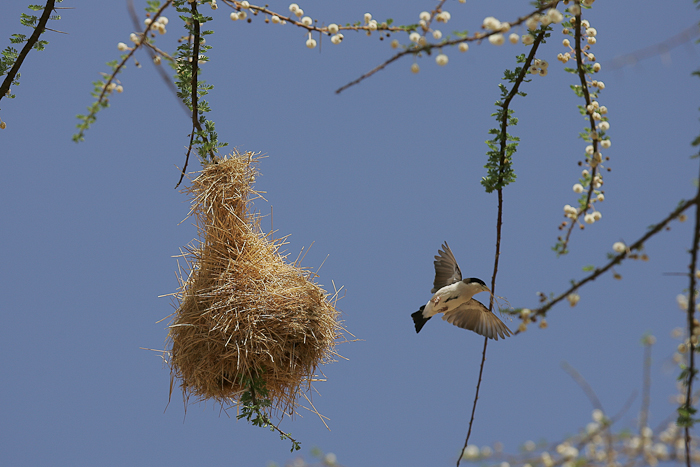 The Social-Weavers (Genus Pseudonigrita) are a different genus from True Weavers (Genus Ploceus), but apart from their colouring – true weavers are mainly predominantly yellow, the social-weavers seem to exhibit similar behaviour. According to Stevenson & Fanshawe’s excellent book, Birds of East Africa, ‘…the Social-Weavers are small birds (4.5″ – 5″) which occur in large flocks, often feeding together on the ground. Their nests are tightly woven balls of grass which hang from the very ends of the the thinnest branches of large trees, often hundreds of pairs breeding together. The sexes are alike.
The Social-Weavers (Genus Pseudonigrita) are a different genus from True Weavers (Genus Ploceus), but apart from their colouring – true weavers are mainly predominantly yellow, the social-weavers seem to exhibit similar behaviour. According to Stevenson & Fanshawe’s excellent book, Birds of East Africa, ‘…the Social-Weavers are small birds (4.5″ – 5″) which occur in large flocks, often feeding together on the ground. Their nests are tightly woven balls of grass which hang from the very ends of the the thinnest branches of large trees, often hundreds of pairs breeding together. The sexes are alike.
The Black-capped Social-Weaver (Pseudonigrita cabanisi) is a ‘small attractive weaver with a black cap and tail contrasting with a brown back and wings, a white bill with a greenish tinge, and red eyes. White below with black streaks on flanks and belly. Flocks inhabit drier country than the Grey-capped Social-Weaver from 200-1300m, including quite arid areas if large trees are present for breeding.’
I spotted this fellow on a trip to Buffalo Springs Game Reserve, Samburu, Kenya. He was one of many busily constructing their nests in a tree that was overflowing with nests.
Canon EOS 1DMkII with Canon 300mm f2.8L IS lens, ISO 200 f4.5 1/2500
by David Clarke | Oct 22, 2012 | All, Kenya, Wildlife

I photographed this fine fellow years ago in the days of film. It was our first trip to Kenya and the Masai Mara, and what a trip!
He was relaxing in the bush at around 9am, having long finished his breakfast. The sun was playing through the branches and highlighting his fur in gloriously brilliant patches. He was totally unfazed by us as we sat in the jeep watching him in awe for ages. Later, he raised himself, stretched and wandered to plan lunch.
Canon EOS3 with Canon 300 f2.8L lens on Fuji transparency film. Scanned and tweaked in Lightroom.
by David Clarke | Sep 8, 2012 | All, Kenya, Places
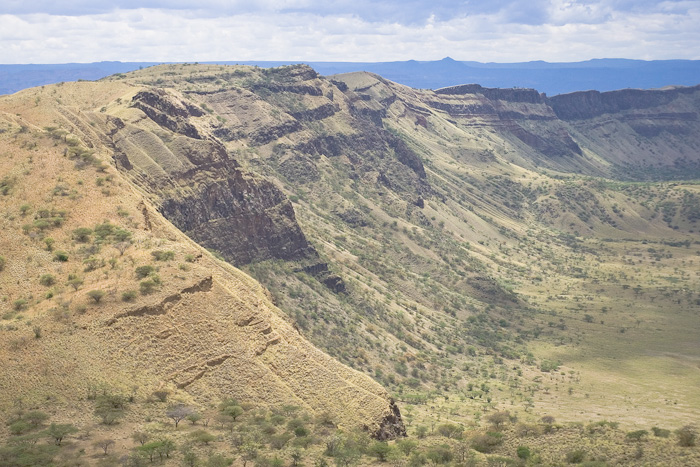
If you like remote, this place is remote! Silali is a volcano situated in the northern Kenya rift valley, which means it’s somewhat off the beaten track!
With a summit elevation of 1578m (5013 ft) above sea level, it has a spectacular summit caldera of 8 × 5 km. with summit walls, as shown in this shot, of up to 300m high. The summit is 600-800 m above the surrounding rift valley floor. Silali was formed some 63000 years ago and had its main eruptions around 7050 – 5050 BC, although there is still geothermal activity there with some eruptions possibly having happened in the last few hundred years.
This shot was taken from a Cessna 4-seater on a trip north-west from Nanyuki down into the rift valley to check out Silali. Although we didn’t fly high enough to get an overall view, we did fly up the outside walls, down into the crater and up the other side; a truly amazing flight.
Much of the above information was gleaned from the site volcano live and there is more interesting stuff at theGlobal Volcanism Program
Canon EOS 1DMkII with Canon 28-70L f2.8 lens at 55m. ISO200 1/5000 at f2.8
by David Clarke | Sep 2, 2012 | All, Kenya, Wildlife
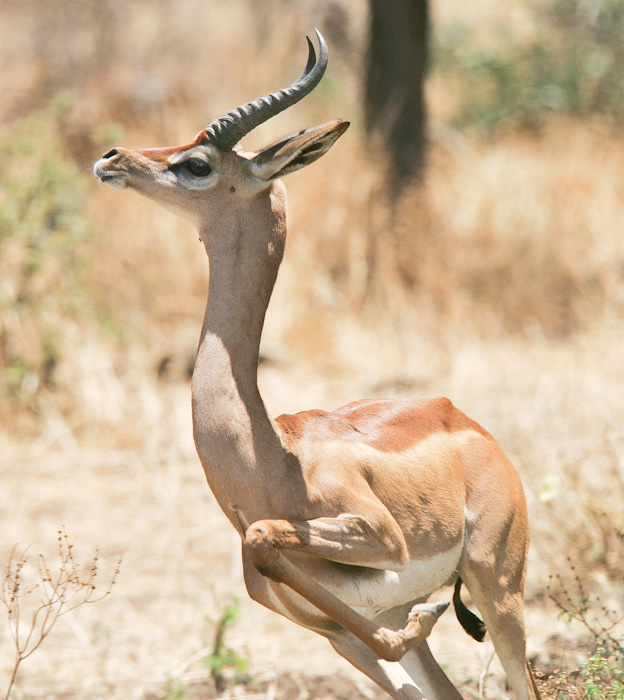
One of the most beautiful antelopes in East Africa, the gerenuk (Litocranius walleri), aka Waller’s gazelle, is incredibly shy. Its name derives from the Somali word for ‘long-necked’.
This male was in the Buffalo Springs Game Reserve in Samburu, Kenya and is probably more used to humans than many. He certainly remained inquisitive while keeping a cautious distance, before suddenly turning tail and heading into the bush – the moment captured here.
Canon 1DMkII with a Canon 300mm f2.8L IS lens & Canon 1.4 extender.
ISO 200 420mm f9 at 1/800
by David Clarke | Aug 27, 2012 | All, Kenya, Wildlife
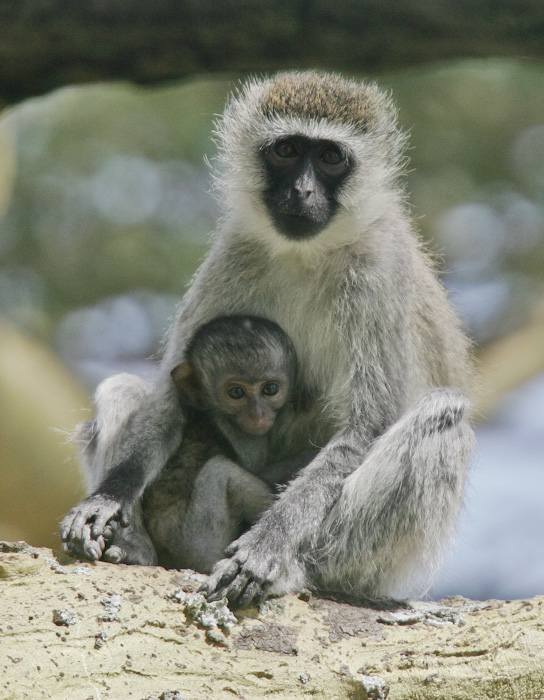
This vervet female with her young offspring were photographed at the Solio Game Reserve in Kenya where there is a thriving population.
Man is the biggest threat to vervet monkeys (Chlorocebus pygerythrus) in the wild.
Notes from the Enkosini Eco Experience website:
In addition to habitat encroachment and urbanization, thousands of vervet monkeys are trapped and sold every year to laboratories worldwide for medical research. Due to the misconception that they destroy fruit crops, vervet monkeys are also systematically eradicated by farmers. In fact, the farming community is responsible for a major portion (73%) of the many orphaned vervet monkey babies that are found in the wild. The vervet monkey is currently listed as a vulnerable species on Appendix Two of CITES (Convention for International Trade in Endangered Species).
Notes from Wikipedia:
The native range of vervet monkeys is sub-Saharan Africa from Senegal and Ethiopia down to South Africa. However, in previous centuries, a number of these monkeys were taken as pets by slavers, and were transported across the Atlantic Ocean to the Caribbean islands. The monkeys subsequently escaped or were released and became naturalized. The descendents of those populations are found on the West Indian islands and there is even a colony in Florida.
Canon 1DMkII with Canon 300mm f2.8L IS lens and Canonx2 extender; ISO 400 f5.6 1/1000.

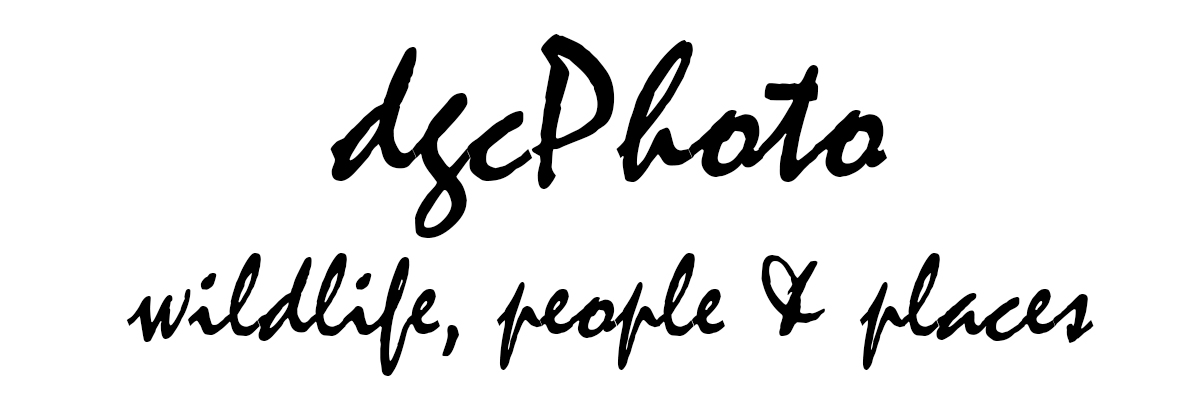

 The Social-Weavers (Genus Pseudonigrita) are a different genus from True Weavers (Genus Ploceus), but apart from their colouring – true weavers are mainly predominantly yellow, the social-weavers seem to exhibit similar behaviour. According to Stevenson & Fanshawe’s excellent book, Birds of East Africa, ‘…the Social-Weavers are small birds (4.5″ – 5″) which occur in large flocks, often feeding together on the ground. Their nests are tightly woven balls of grass which hang from the very ends of the the thinnest branches of large trees, often hundreds of pairs breeding together. The sexes are alike.
The Social-Weavers (Genus Pseudonigrita) are a different genus from True Weavers (Genus Ploceus), but apart from their colouring – true weavers are mainly predominantly yellow, the social-weavers seem to exhibit similar behaviour. According to Stevenson & Fanshawe’s excellent book, Birds of East Africa, ‘…the Social-Weavers are small birds (4.5″ – 5″) which occur in large flocks, often feeding together on the ground. Their nests are tightly woven balls of grass which hang from the very ends of the the thinnest branches of large trees, often hundreds of pairs breeding together. The sexes are alike.




